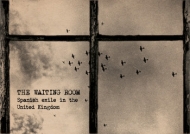The Waiting Room
Date uploaded: March 30, 2015
IC Communication in association with Cervantes Institute London presents The Waiting Room: Spanish Exile in the UK in literature, art, film and music. The exhibition runs from the 28th of April to the 30th of June 2015 and celebrates the unique contribution to British cultural life of the writers and poets who came to the UK from Spain during the Civil War. It explores the crucial role they played in the Allied cause, as exiles facing great political and personal challenges.
Presented as an eight-week programme of art, literature, music and film, The Waiting Room unfolds through the stately spaces of the Cervantes Institute as it prepares to leave the home it has occupied for almost 70 years. Drawing on the lives and work of some of Spain’s most significant literary figures - Arturo Barea, Luis Cernuda, Manuel Chaves Nogales, Salvador de Madariaga and Rafael Martinez Nadal amongst others – The Waiting Room presents contemporary perspectives on the contributions they made to identity, culture, politics and society in twentieth-century Britain.
Central to The Waiting Room are the writers Arturo Barea and Manuel Chaves Nogales, whose lives and work are explored in an exhibition featuring photography, books and writing.
Active at the outbreak of the Civil War, Barea later worked in the Foreign Ministry’s Press Office where he got to know Ernest Hemingway and other foreign journalists, and during the Seige of Madrid, became known as An Unknown Voice of Madrid, for his nightly broadcasts about daily life in the besieged city. Arriving in London in 1939, he began working for the Spanish section of the BBC World Service and became a prolific writer, producing biographies, short stories, a novel and journalism, until his death in 1957. The Waiting Room also presents weekly screenings of the TV adaptation of his best-known work and autobiography, The Forging of a Rebel. A new commission by Jordi Ruiz Cirea, Catalan photographer and 2012 winner of the Taylor Wessing Portrait Photography Prize, explores the rarely seen archive of his work before it enters the Bodleian Library in Oxford.
Manuel Chaves Nogales, an anti-fascist and anti-revolutionary editor, journalist and writer left Spain, as did many intellectuals, when the government abandoned Madrid for Valencia. His prodigious literary output includes one of the best-known books on bullfighting, Juan Belmonte, killer of bulls; and Heroes, Beasts and Martyrs of Spain, considered to be a classic reflection on the suffering of both sides during the Civil War. On the Gestapo hit list for denouncing Nazism, he fled Paris for England as the German army approached the city. In London he became director of The Atlantic Press Agency, wrote a column for the Evening Standard and collaborated with the BBC on their overseas broadcasts. He died in 1944 and lies buried in an unmarked grave in west London. Nominated for a Goya award in 2014, The Waiting Room presents The Man Who Was There (dr. Antonio Rubio), a documentary about his life, introduced by Chaves Nogales’ British grandson, Anthony Jones.
In other events the life of exiled Catalan composer Roberto Gerhard is remembered in a concert with guitarist Laura Ruhí-Vidal and soprano María Camahort; acclaimed poet Luis Cernuda is brought to life through a talk by his biographer, the award-winning writer Antonio Taravillo and a poetry recital by Jorge de Juan, actor, and artistic director of the Spanish Theatre Company in London. Contrasting Arturo Barea’s love affair with the English countryside, with Spanish writer and theologian Joseph Blanco White’s experience in Liverpool, Nigel Townson, Senior Lecturer at the University Complutense, Madrid and writer and academic Martin Murphy discuss exiles views on England.
Poetry insinuates its way through the Cervantes Institute with Windwall, a new site-specific commission by born-in-exile Spanish visual artist Gloria García Lorca, niece of international poet, playwright and theatre director, Federico García Lorca. Fusing sculpture and spoken word on the walls inside the building, García Lorca explores ideas of exile, memory and absence in a place with its own role in Spanish history. Disappointed exiles saw it as a consolidation of Franco’s favour in Britain when it reopened as the official cultural centre of Spain after World War II, though when democracy came, it transformed into the Cervantes Institute.
For further information, images and interviews please contact Janette Scott Arts PR on [email protected] or +44(0)7966 486156.

